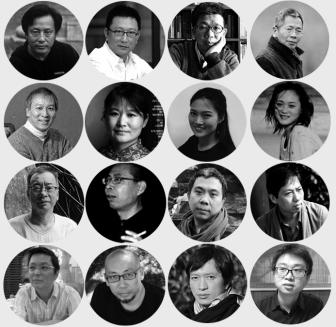Article
南方诗歌:去中心化,朝向一种地缘生态诗学
Southern Poetry: Decentralization and Toward a Geo-ecopoetics in China

November 23, 2019
Who are the contemporary Qu Yuans? How do we define “South” today? We can draw a line along the Yangtze River eastward: Qinghai, Tibet, Sichuan, Yunnan, Chongqing, Hubei, Hunan, Jiangxi, Anhui, Jiangsu, and Shanghai. Then further south: Guizhou, Guangxi, Guangdong, South Sea Island, Macau, Hong Kong, (Taiwan), back to the mainland to Fujian, and up to Zhejiang. This mapping of the “South” includes Southwest, South, further South and Southeast China, i.e. the entire Southern half of China. This geographical mapping is not only justified by the natural flow of the river, but more by the poetry in these regions, thematically and style-wise. The point here, however, is not in finding commonalities in Southern poetry, but to highlight individual characteristics, as well as interesting differences from the mainstream poetry in China.
Contemporary awareness and the proposal for Southern poetry (as against the Northern/Beijing supremacy) started in 1982 with the rising of the Third Generation Poets in Sichuan province: Hu Dong, Zhao Ye, and many others. Zhong Ming (1953-) was the first and foremost promoter of Southern Poetry as expressed in his independent journal Secondary Forest (1982). While the Third Generation Movement quickly spread to other parts of China including Beijing as a generational rebellion against mainstream poetry as well as against Misty poetry (and also against being labeled as “Post-Misty” poets), Southern poetry evolves slowly but has a much longer life. It’s preceded by the poetic works of Chang Yao (1936-2000), Huang Xiang (1941- ), Ya Mo (1942- ), Ye Si (1949-2013), to name just a few. (It can even be traced back to the first wave of modernism in China in the 1920-30s, since most of the early “New Poetry” poets were from the Southern regions of China and carried the Southern temperament in their writings.)
The various avant garde groups of the Third Generation such as Macho Men, Not Not Poets, Holistic Poetry, Sa Jiao (gentle resistance), the “Them” Group, On the Sea, City Poets, Campus Poets, etc., dissolved around 1989, but the consciousness of Southernness and spirit of rebellion continues in the 21st century. Today, a majority of the Southern poets are still overshadowed by the international fame of the Misty poets, and the domestic prominence of the mainstream and “system-favored” poets. The Southern poets – with their reinvented poetic forms and “make-it-new-day-to-day” language – are overshadowed even though they outshine the more well-known Chinese writers. Being translated or not should never be a true criteria of judging who is good who is not.
“South may be a geographical name, but it should be defined as a spiritual dimension.” This is the first line of the short preface in the independent journal, Southern Poetry, edited by Chen Dongdong in Shanghai in 1992 (and which was suppressed in 1994). I take “spiritual” as “ideological” and can’t agree more. But I think that geographical and ecological dimensions are also worth looking into. In multiple interviews, Chen Dongdong states that the journal was named by Zhong Ming as parallel to the latter’s Southern Review, launched at the same time in Chengdu (which only published two issues before being suppressed).
Chen avers that to talk about Southern poetry vs Northern/Beijing poetry is without poetic significance, and that what he writes is Chinese poetry, not Southern poetry, even though his poetry has Southern characteristics. Similarly, back in 1986, when Song Wei and his brother (the Holistic poetry group) published the independent magazine-book, Chinese Poetry: Chronicles of the 20th Century, they didn’t name it Sichuan poetry or Southern poetry but gave it a much broader name. I don’t, however, see a real difference between those who promote Southern poetry or their local poetry in the Southern areas and those Southerners who don’t identify themselves as Southern poets.
Like two sides of a coin, one side emphasizes the secondary position of the South vs Northern supremacy, the other side sees Southern as no less than Chinese, itself, in its entirety. With the re-discovery of Sanxingdui ruins (c. 2800-1100 BCE) in Sichuan in the1990s, Zhong Ming proposed that Yangtze River culture in the South developed earlier than Yellow River culture in the North, negating the latter as the sole source or the center of Chinese cultures. It is in supporting the argument by Zhong Ming that I’m putting forth for the study of Southern poetry in China. The long history of Southern tradition cannot be ignored.
Furthermore, most of the “minority” ethnic communities reside in the southern regions, and their distinctively different cultures and languages have enriched Southern literature. Even the Han people in the South speak dialects that are different from standard Northern speech (most of them translate the dialects into standard Chinese mentally when writing poetry.) While numerous archaeological sites dated 7500 BCE to 1200 BCE have been discovered along the Yangtze River, the Three Gorges Dam has buried many of them and destroyed the ecological balance in the midstream of the Yangtze River. It will be enlightening to note how ecological concerns, if any, are voiced out by courageous poets.
Southern poets featured on the Poetry International Rotterdam website so far: Jiang Hao, Ya Shi, Sun Wenbo, Chen Jun, Li Heng, Song Wei, Ya Mo, Mo Mo, etc.
and ethnic “minority” poets from the southern regions: Aku Wuwu, Kawa Niangji, Jike Bu, Feng Na.
More will be featured in April 2020.
What else contributes to the Southernness in the poetry of Qu Yuan (c. 340-278 BCE) besides his peculiar syntax and interjections, use of shaman mythologies and his status as an exile? Does this Southernness continue in contemporary Chinese poetry? If so, has it expanded the aesthetic space in contemporary imaginations? Prior to Qu Yuan’s time, Southern style was observed in poems from the southern kingdoms in the first collection of poetry in China, The Book of Songs. What makes those poems Southern apart from their geography? The Southern dialects as reflected in the tones and vocabularies? The Southern landscapes and rural cultures? What else?
There is a long history of pinpointing the strangeness about the southern “barbarian” regions in the land later called China. The division of North and South encompasses a wide range of oppositions in literature: realism vs romanticism, rationalism vs witch culture, Confucianism vs Daoism (Taoism), Yellow River culture vs Yangtze River culture. If we narrow down to contemporary time, Misty vs Third Generation poetry. If we focus on the last 30 years, “intellectual” writing vs spoken language poetry, among other things. Due to migration and relocation, there is a large degree of overlap in terms of the current whereabouts of the poets. But the concept of Southernness is about more than just geographical location. It is about an ideal independent poetry because North and South, to many writers, stand for central vs peripheries, and government vs people.
Still considered the first great poet in Chinese history, Qu Yuan is highly regarded as the first "patriotic" poet of Romanticism by mainstream institutions, while on the independent side he symbolizes almost every aspect of what independent poetry is about even today: total failure in an official career, distrusted by the Royal system, bravely asking Heavenly Questions, longing for a surreal power to overcome hardships, juxtaposing mythologies and realities, creating a new form, using idiosyncratic syntax and vocabularies, unusual imagery and never-heard-of plants and places at the remote edges of land on the journeys of exile, etc. etc. His metaphor of vanilla beauty has been reinterpreted as a patriotic gesture, loyalty to the Chu Kingdom, but independent poets take it as a type of mutual appreciation among bosom friends, extremely important today when you don’t have support from a literary institution.Who are the contemporary Qu Yuans? How do we define “South” today? We can draw a line along the Yangtze River eastward: Qinghai, Tibet, Sichuan, Yunnan, Chongqing, Hubei, Hunan, Jiangxi, Anhui, Jiangsu, and Shanghai. Then further south: Guizhou, Guangxi, Guangdong, South Sea Island, Macau, Hong Kong, (Taiwan), back to the mainland to Fujian, and up to Zhejiang. This mapping of the “South” includes Southwest, South, further South and Southeast China, i.e. the entire Southern half of China. This geographical mapping is not only justified by the natural flow of the river, but more by the poetry in these regions, thematically and style-wise. The point here, however, is not in finding commonalities in Southern poetry, but to highlight individual characteristics, as well as interesting differences from the mainstream poetry in China.
Contemporary awareness and the proposal for Southern poetry (as against the Northern/Beijing supremacy) started in 1982 with the rising of the Third Generation Poets in Sichuan province: Hu Dong, Zhao Ye, and many others. Zhong Ming (1953-) was the first and foremost promoter of Southern Poetry as expressed in his independent journal Secondary Forest (1982). While the Third Generation Movement quickly spread to other parts of China including Beijing as a generational rebellion against mainstream poetry as well as against Misty poetry (and also against being labeled as “Post-Misty” poets), Southern poetry evolves slowly but has a much longer life. It’s preceded by the poetic works of Chang Yao (1936-2000), Huang Xiang (1941- ), Ya Mo (1942- ), Ye Si (1949-2013), to name just a few. (It can even be traced back to the first wave of modernism in China in the 1920-30s, since most of the early “New Poetry” poets were from the Southern regions of China and carried the Southern temperament in their writings.)
The various avant garde groups of the Third Generation such as Macho Men, Not Not Poets, Holistic Poetry, Sa Jiao (gentle resistance), the “Them” Group, On the Sea, City Poets, Campus Poets, etc., dissolved around 1989, but the consciousness of Southernness and spirit of rebellion continues in the 21st century. Today, a majority of the Southern poets are still overshadowed by the international fame of the Misty poets, and the domestic prominence of the mainstream and “system-favored” poets. The Southern poets – with their reinvented poetic forms and “make-it-new-day-to-day” language – are overshadowed even though they outshine the more well-known Chinese writers. Being translated or not should never be a true criteria of judging who is good who is not.
“South may be a geographical name, but it should be defined as a spiritual dimension.” This is the first line of the short preface in the independent journal, Southern Poetry, edited by Chen Dongdong in Shanghai in 1992 (and which was suppressed in 1994). I take “spiritual” as “ideological” and can’t agree more. But I think that geographical and ecological dimensions are also worth looking into. In multiple interviews, Chen Dongdong states that the journal was named by Zhong Ming as parallel to the latter’s Southern Review, launched at the same time in Chengdu (which only published two issues before being suppressed).
Chen avers that to talk about Southern poetry vs Northern/Beijing poetry is without poetic significance, and that what he writes is Chinese poetry, not Southern poetry, even though his poetry has Southern characteristics. Similarly, back in 1986, when Song Wei and his brother (the Holistic poetry group) published the independent magazine-book, Chinese Poetry: Chronicles of the 20th Century, they didn’t name it Sichuan poetry or Southern poetry but gave it a much broader name. I don’t, however, see a real difference between those who promote Southern poetry or their local poetry in the Southern areas and those Southerners who don’t identify themselves as Southern poets.
Like two sides of a coin, one side emphasizes the secondary position of the South vs Northern supremacy, the other side sees Southern as no less than Chinese, itself, in its entirety. With the re-discovery of Sanxingdui ruins (c. 2800-1100 BCE) in Sichuan in the1990s, Zhong Ming proposed that Yangtze River culture in the South developed earlier than Yellow River culture in the North, negating the latter as the sole source or the center of Chinese cultures. It is in supporting the argument by Zhong Ming that I’m putting forth for the study of Southern poetry in China. The long history of Southern tradition cannot be ignored.
Furthermore, most of the “minority” ethnic communities reside in the southern regions, and their distinctively different cultures and languages have enriched Southern literature. Even the Han people in the South speak dialects that are different from standard Northern speech (most of them translate the dialects into standard Chinese mentally when writing poetry.) While numerous archaeological sites dated 7500 BCE to 1200 BCE have been discovered along the Yangtze River, the Three Gorges Dam has buried many of them and destroyed the ecological balance in the midstream of the Yangtze River. It will be enlightening to note how ecological concerns, if any, are voiced out by courageous poets.
Southern poets featured on the Poetry International Rotterdam website so far: Jiang Hao, Ya Shi, Sun Wenbo, Chen Jun, Li Heng, Song Wei, Ya Mo, Mo Mo, etc.
and ethnic “minority” poets from the southern regions: Aku Wuwu, Kawa Niangji, Jike Bu, Feng Na.
More will be featured in April 2020.
© Ming Di
Sponsors





Partners
LantarenVenster – Verhalenhuis Belvédère

